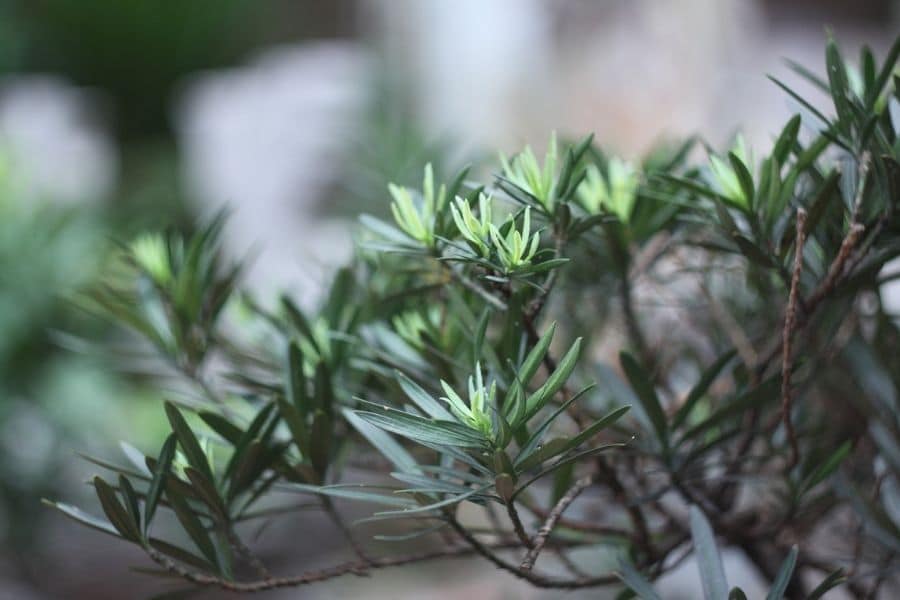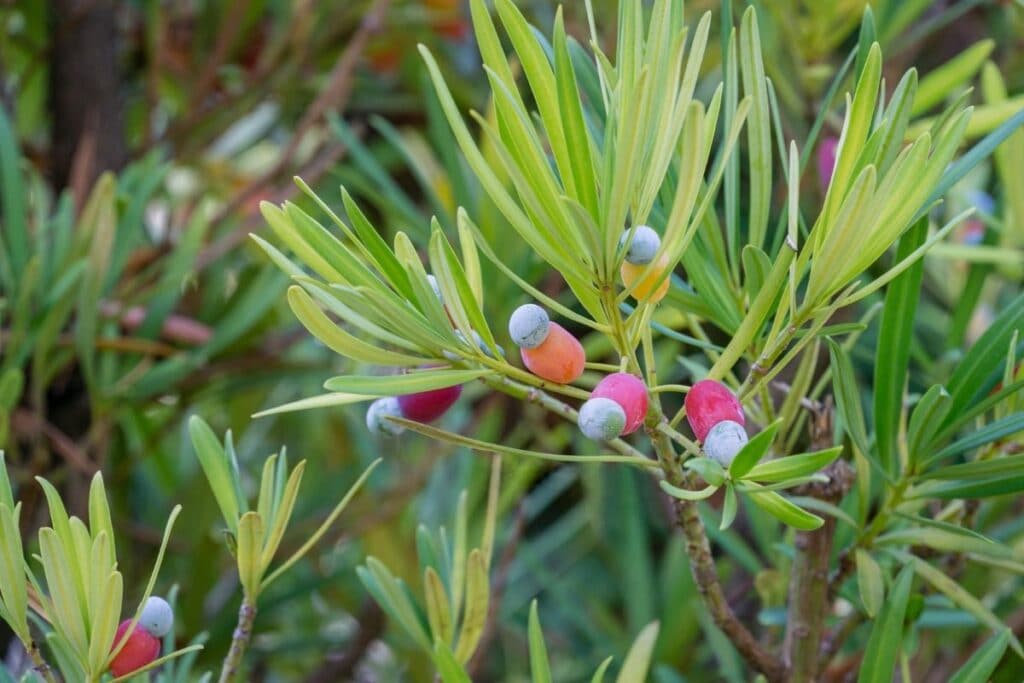Podocarpus macrophyllus is a plant that goes by many names and has many uses. These plants are particularly popular for hedging, especially in the American southeast and on the west coast.
Read on to learn more about how to grow and care for these wonderful evergreen shrubs and trees.
What Is A Podocarpus?
Podocarpus are broadleaved conifers of the family Podocarpaceae. Podocarpus macrophyllus is a very popular species that has many common names, including yew plum pine, Chinese yew, Japanese yew, southern yew, yew pine, Buddhist pine, and fern pine.

The yew plum pine is an evergreen tree that can reach impressive heights of up to over 60ft (18m) but is very often grown as a shrub and kept to 6ft (1.8m) tall or so. These shrubs take on a naturally upright and narrow shape, which makes them an ideal choice for tight spaces.
This podocarpus is native to southern China and Japan where it can be found growing in forests and thickets.
The pleasantly fragrant leaves of this plant are 2-5 inches (5-12.5cm) long, elongated, and narrow. New growth is an attractive light green or even pink to bronze in some selections, becoming dark green when mature. These plants have smooth, light brown to grey-brown bark which becomes flaky with age.
There is a subspecies known as Maki that is a smaller, slower-growing plant and a variety known as MoodRing which produces beautiful reddish-bronze new growth.
Podocarpus Flowers
Being conifers, the plum pine plants don’t produce regular flowers but do produce unusual and attractive cone structures. The elongated yellow pollen cones are attractive but not very showy.
Yew pines also produce fruit-like structures that consist of blue, reddish purple, or red arils with 1 or 2 greenish seeds of around ¼ inch (6mm) long attached to them.
These structures function like fruits, attracting birds that feed on them and disperse the seeds. They are produced in the summer and fall.

How To Grow A Podocarpus Tree
This podocarpus plant can be grown from seed or propagated from cuttings. Tip cuttings of around 5 inches (12.5cm) in length usually take root after 10-12 weeks.
They grow best in well-drained, fertile soils that are rich slightly acidic. Being quite salt-tolerant, they grow well near the coast.
The soil should be kept moist, but avoid wet soils since these plants do not tolerate saturated substrate. Although they are considered drought tolerant when mature, young podocarpus should be watered on a regular basis until well rooted and established in their planting site. Allow the soil to drain well between watering to prevent root rot.
Full sun to part shade in USDA zones 8-10 is ideal for growing podocarpus, and they can also be grown indoors in bright, sunny positions in cooler areas. These trees will grow in areas without direct sunlight but will develop a more open growth form.
Care and Maintenance
Podocarpus plants are slow-growing, low-maintenance shrubs. They can be pruned at any time of the year, although it is better not to prune in the period leading up to the first frosts as the new growth you will encourage may not have a chance to harden off in time and may be damaged by the cold.
Pruning by hand is generally recommended, although these plants are well suited to trimming and make for good topiary specimens and formal hedges.
Although not necessary in naturally fertile soil, a balanced general purpose fertilizer will promote more vigorous growth where needed.
This yew podocarpus is rather pest and disease resistant, although they can be mildly affected by a few different pests, disease problems, and conditions. Scale insects, mites, fungal leaf spots, sooty mold, and nematode damage may appear on indoor plants. Podocarpus is naturally deer resistant.
Uses
Horticultural uses
Podocarpus bush makes a great formal or informal hedge, screen, or border plant. These plants can be grown indoors in containers, provided they get enough light, and plants grown in containers can also be overwintered indoors in areas colder than about zone 8.
These plants make attractive specimens and can even be shaped as topiary plants. Their narrow, upright growth form and non-invasive roots make them an ideal choice where ground space is limited. The yew plum pine is a popular bonsai species amongst bonsai enthusiasts.
Human uses
While the fleshy arils of yew pines are known to be edible, the seeds themselves are toxic and should not be eaten.
Wildlife uses
Birds eat the arils and spread the seeds of these plants.
FAQs
Is Yew the same as Podocarpus?
Yew (Taxus) and Podocarpus are different plant genera. Yew belongs to the Taxaceae family, while Podocarpus is a genus in the Podocarpaceae family. They are distinct plants with different characteristics.
What is Podocarpus macrophyllus used for?
Podocarpus macrophyllus, also known as the Buddhist pine or yew pine, is often used as an ornamental plant in landscaping and gardens. It is valued for its dense, evergreen foliage and is commonly shaped into hedges or screens.
Is Podocarpus Yew poisonous?
While Podocarpus macrophyllus is sometimes called “yew pine,” it is not the same as true yew (Taxus), which is known for its toxicity. Podocarpus macrophyllus is generally considered non-toxic and is not known to contain the toxic compounds found in true yew. However, caution is always advised, and it’s essential to confirm specific plant varieties and consult local resources for accurate information on toxicity.
Conclusion
Such a useful plant has a place in almost any garden in zones 8-10. Being a slow grower, this beautiful plant requires a little patience from the gardener, but the rewards are definitely worth it. If you’re looking for a neat and classy evergreen plant that needs little maintenance, go ahead and plant a podocarpus tree this year.
*image by Marinodenisenko/depositphotos






